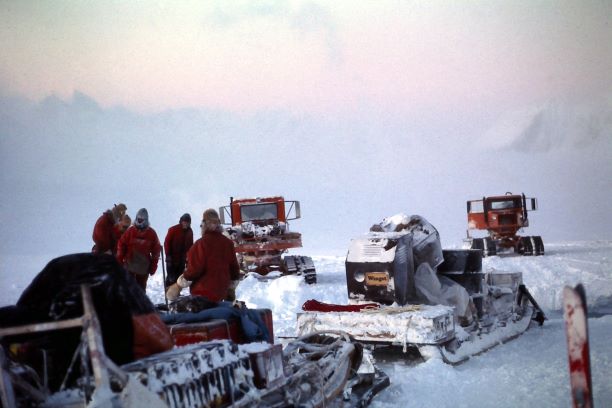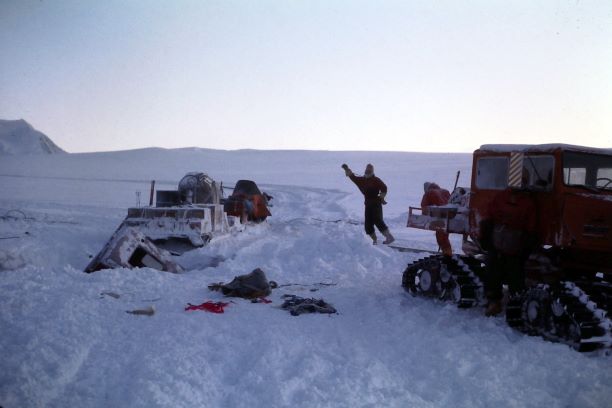Tractor Journey – Adelaide to Rothera, July 1976 – Alec Hurley
All Photos by Alec Hurley
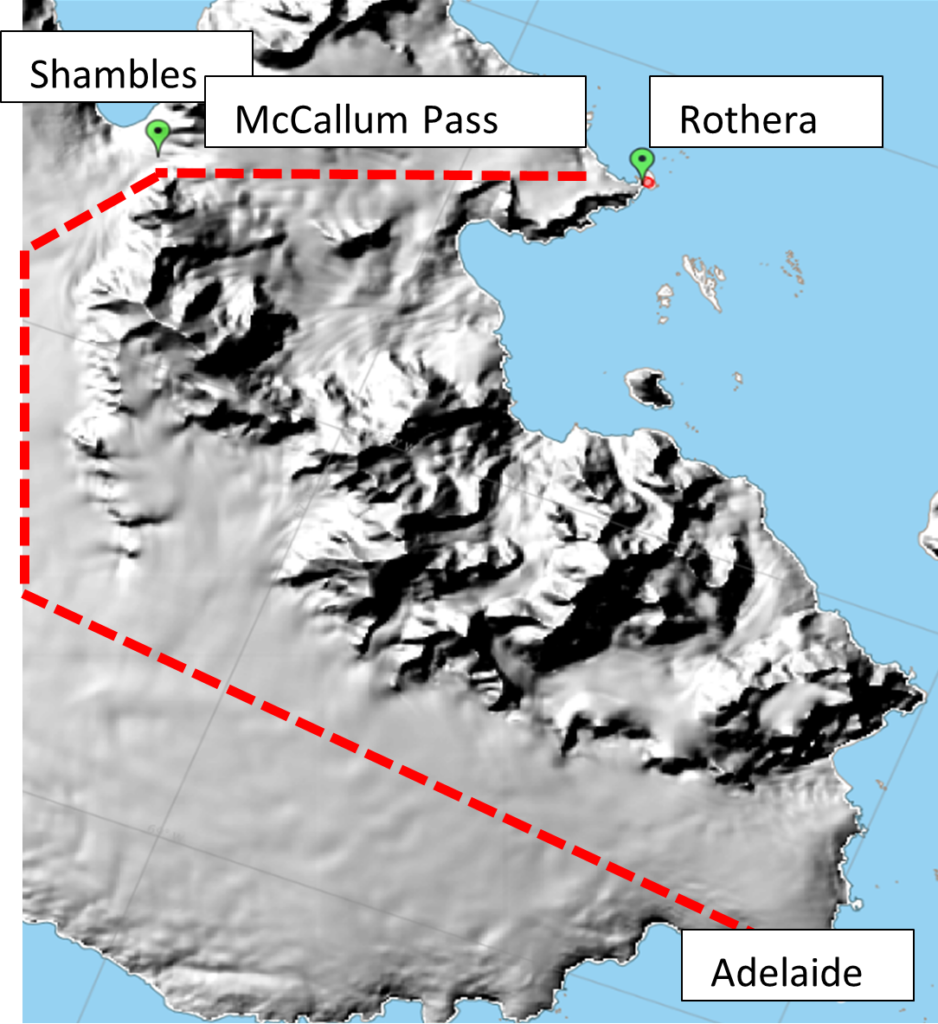
Following a difficult relief at T base the previous season, ending up with the loss of the ‘Magic Bus’ (Muskeg Crane) off the jetty, it was decided to move some of the key machinery overland ready for the Phase II build of the new Rothera base later that year.
July 12th – Heading Out
The Rothera team Brian, Andy, Colin & Alec left early afternoon with improving weather. The Adelaide team, Rob, Trevor, Tony, Don and Dave were already on their way. The plan was to meet in approximately 2 days at the top of the Shambles Glacier. With the light fading, Team Rothera camped at the top of the McCallum Pass, well above the cloud which lay on the Shambles below.
Continuing from Rothera 1976….
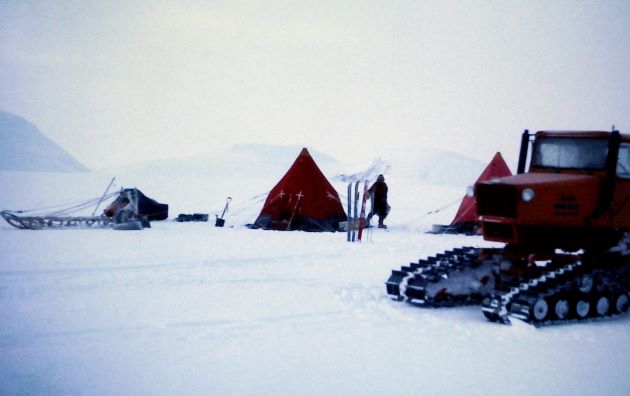
July 13th – Bottom of the Shambles Glacier
The morning was cold and cloudy. Colin and I set about the morning ritual of preheating and starting the tractors, whilst Brian and Andy marked a route to the bottom of the Shambles. Running into holes and deteriorating weather conditions after the second attempt to find a route up the glacier, Brian and Andy returned to help guide us down from the pass and pitching camp for the second night.
July 14th – Meeting Up
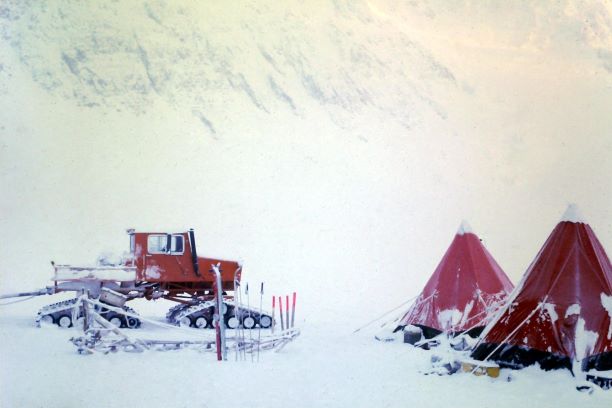
We had overcast and poor contrast conditions all day and were surprised to hear that the Adelaide team were close, with their progress halted by a 20ft hole at the top of the Shambles. Andy and Brian drove up to meet them and it was agreed that due to the prevailing weather conditions not to proceed further until it improved.
July 15th – On the Shambles Glacier
A perfect weather day, the 20ft open crevasse at the top of the Shambles was investigated further by Trevor and the route taken by the skidoo’s the previous night was examined probing further holes. The vehicles were started and the Rothera team proceeded slowly up the glacier close to the rock cliffs to meet the Adelaide party. Nearing the 20ft wide crevasse, a lower bridge route was chosen for a successful crossing by the Snow Cats.
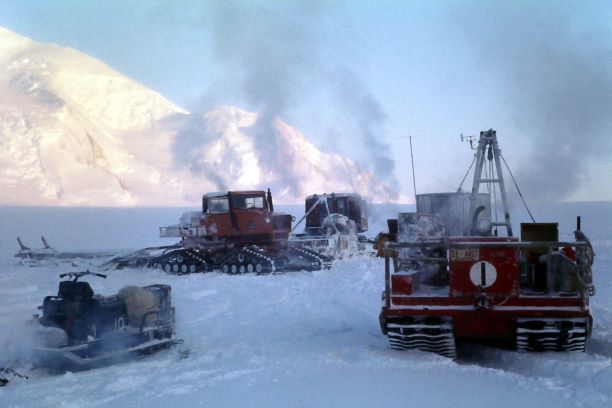
At the top camp loads were reshuffled in preparation for the return journey down the Shambles. After further checking and probing of the ascending route the tractor train set off lead by the large V8 Snow Cat towing a sledge and the caboose followed by the smaller Snow Cat and Muskeg, with ‘Mary’ the I.H. pulling two sledges at the rear. Using the skidoos an advance party were positioned at the major crevasse crossing points and the descent commenced. The Snow Cats and the Muskeg all successful cross the first snow bridge, but unfortunately ‘Mary’ didn’t, dropping into the crevasse nose first almost! Rob who was driving was quickly pulled out via the roof hatch, a little shaken, but not injured and more concerned about the cameras which had fallen from the cab.

The remainder of the day was spent by Rob and Trevor retrieved their cameras from the floor of the crevasse, while the rest of us set about organising winching tackle and digging holes for the dead men to secure Mary overnight. With the dead men positioned this also allowed the rear sledge to be uncoupled, winched clear and pulled over the crevasse by Snow cat. We all returned to camp at the bottom of the Shambles for dinner and rest. No contact with Adelaide, since yesterday.
July 16th – Mary and the Crevasse Edge
The day started with digging a ramp down to Mary and winching away the second sledge . However the sledge was not about to move due to the ‘A’ frame and wire strop still being under tension between Mary and the crevasse edge. It was obvious that we need to increase our winching power and attached wire strops has low as possible to Mary and release the sledge. Using the heavy timber from the crevasse bridge we increased the size and lowered the dead men into the compacted snow, ensuring the hawser was level between deadman and Mary’s tow hitch. The increase pull to (approximately 12 tons) released the tension allowing the the sledge to be removed and the ramp to be be extended. With the temperature between-25°C to-35 all day the smoko tent pitched at the scene was a life saver for periodic warming of hand and sustenance. No radio contact with Adelaide base, despite using 2 radios. By the end of a hard days graft by the whole team we all departed if not a little weary for the camp below.
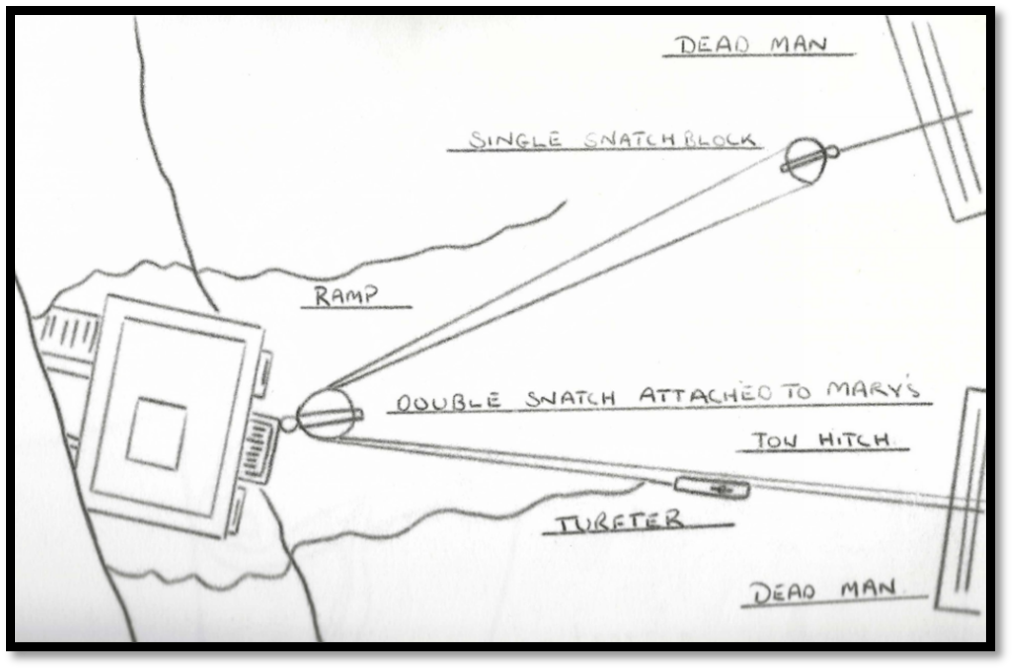
July 17th – Kodak Shares Soar
The extraction of Mary started today and Kodak shares soared. Early prioity was to complete the ramp and then to get Mary level on her tracks. Chipping of the remaining ice under the right track contined whilst maintaining pressure via the block and tackle. Gradually the vehicle squared up and finally started inching backwards out of the hole on to the ramp. At this point Mary’s blade and C frame, which was damaged on impact, started to impede progress over the crevasse lip and causing the left hydaulic ram to press hard against the radiator cowl. Using a skidoo tufter the blade and frame were winched clear and Mary was successfully on solid ground. Throughout the whole recovery process safety was a concern and with the risk for Mary moving and or crevasse edge collapse this work was undertaken with care, working individually and roped up.
July 18th – Mary Out, Up and Running
Third day of miserable weather, poor contrast with a breeze making progress slow. The Herman Nelson heater had been pulled the half a mile from the camp and was warming up Mary’s engine ready for an attempted start. We were concerned that further damage may had occurred so a detailed inspection for any leaks was carried out, whilst the ramp was cleared of last night’s snowfall and drift accumulation. Luckily other than replacing the lost engine oil while she was hanging in the hole, there appeared to be no further issues, and Mary was running and soon at the top of the ramp.
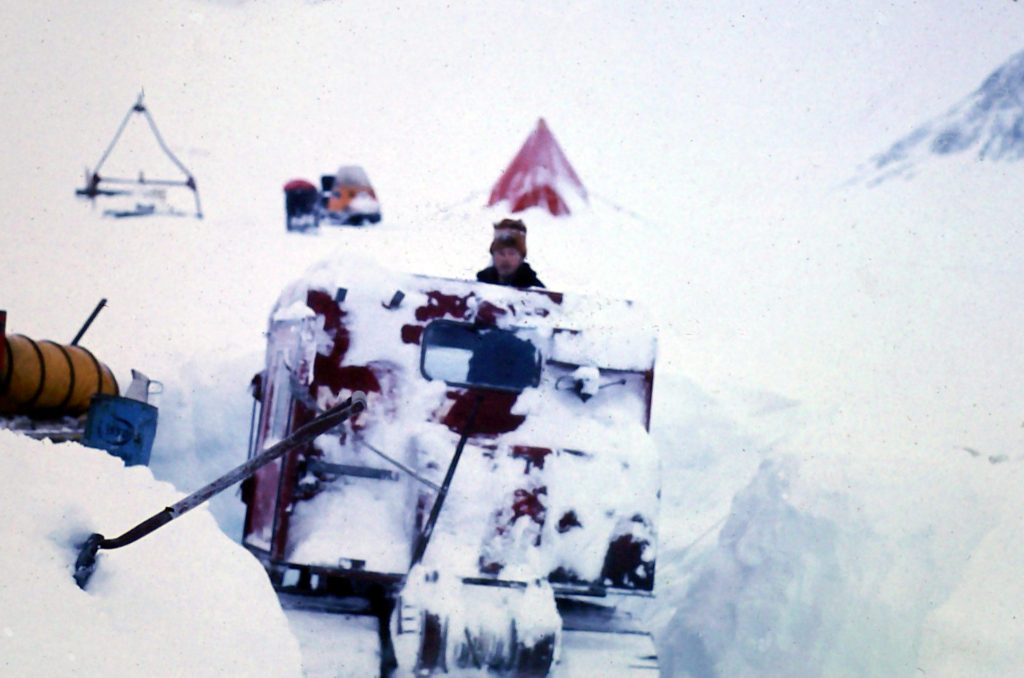
The task of dead man recovery (re crevasse bridges) was made easy with Mary’s winch and while a lost fuel drum was attached for lifting from the hole Trevor looked for the best crossing bridge from underneath. The point was just 50ft away and much narrower with both sides of the crevasse was identified allowing our home-made bridges to be used.
However, learning from earlier mistakes, Mary crossed the bridge remotely without a hitch via ropes operated by Rob attached to steering clutch levers. With the remaining equipment and last sledge on the Rothera side, in poor light we return to camp.
July 19th – Lie Up
Laid up due to bad weather, finally made contact with Adelaide base after 3-day blackout.
July 20th – Mary at the bottom of McCallum Pass
Blue skies, 20 knot winds and blowing snow. After a slow start due to both tractors and skidoo’s needing help in starting, Andy and Dave headed out for Rothera to ensure our stove didn’t run out of fuel. The rest of us headed back up the glacier to clear up the remaining equipment and with Rob sat on the sledge behind Mary we set off.
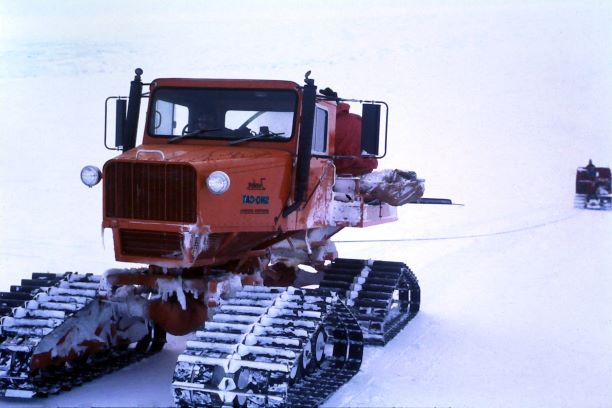
Earlier that morning the route down the Shambles was rechecked, looking for potential holes ahead and probing obvious areas. Before Mary had moved 10ft she broke one open luckily only 2.5ft wide, however the decision to steer remotely was confirmed and luckily apart from another small 1ft hole opening up the remaining trip to base camp was trouble-free.
After a lunch of hot soup, whilst everyone else started digging out sledges Brian and Rob went on ahead with a skidoo taking Mary to the bottom of the McCallum, with the hope of a prompt start next morning.
Following a recce up the McCallum and with deteriorating weather Brian and Rob returned to base camp to join us concluding the day’s activities.
July 21st
Laid up due to blow – no radio contact
July 22nd
Laid up due to blow – no radio contact
July 23rd – The Run in to Rothera
Finally, a reasonably clear day for the run into Rothera. With all the vehicles running at base camp the heater was moved to Mary at the bottom of the McCallum, but unfortunately initial attempt to start her failed and charging generator was used to boost her batteries.
Meanwhile the Snow Cats and Muskeg took the sledges and the caboose up the pass, thankfully the feared large crevasse at the top showed no sign of its presence. With the weather improving we set off for the final time up the McCallum. Due to the soft snow accumulation and to distribute weight more evenly (without her blade) Mary was driven in reverse tethered via a wire hawser to the Snow cat. 20 minutes later Rob and I were at the top of the Pass. Radio contact made finally with Adelaide and we all headed for Rothera.
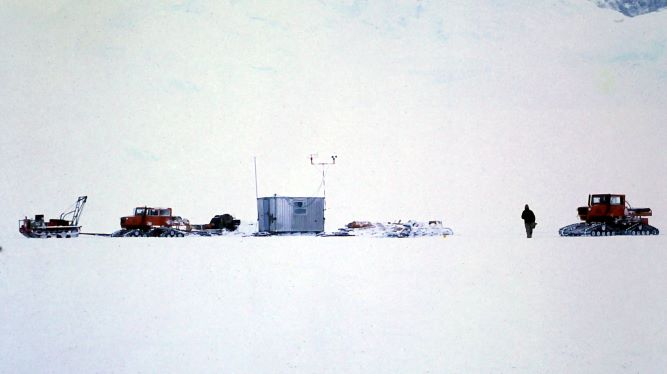
The caboose was dropped off at the snow air strip ready for the summer field season, and in a last defiant act Mary ran out of fuel at the top of the traverse. She was left and collected the next day.

Acknowledgements
Special thanks to Brian Sheldon and his trip report, after 44 years my memory of the detail has faded.
Rothera Team: Brian Sheldon, Andy Turner, Colin Horton, Alec Hurley
Adelaide Team: Rob Davis, Trevor Phillips, Tony Salmon, Don Hadley, Dave Ball
Days in the Field
Laid up 3
Mary’s Extraction 3
Travelling 6
Alec Hurley, DEM – Halley 1975, Rothera 1976


